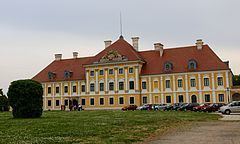Completed 1751 Opened 1751 Construction started 1749 | Current tenants Vukovar City Museum Renovated 2008–2011 Architectural style Baroque architecture | |
 | ||
Address Županijska 232000 Vukovar Similar Gradski muzej Vukovar, Vučedol Culture Museum, Ilok Castle, Vukovar water tower, Prandau‑Normann Castle | ||
Eltz Manor (Croatian: Dvorac Eltz, German: Schloss Eltz) is a Baroque castle in Vukovar, Croatia. The 18th-century manor is the location of the Vukovar City Museum. The manor, as it previously appeared, is depicted on the reverse of the Croatian 20 kuna banknote, issued in 1993 and 2001. The castle was destroyed in 1991 in the Croatian War of Independence. However, after four years of restorations, it was completely restored to its pre-war appearance in October 2011.
Contents
Map of Eltz Manor, 32000, Vukovar, Croatia
History
In 1736, Philipp Karl von Eltz-Kempenich (1665–1743), the Archchancellor of the Holy Roman Empire and Prince-Archbishop of Mainz, purchased a Vukovar manor in Syrmia, in the eastern Kingdom of Slavonia, then part of the Habsburg Monarchy ruled by Emperor Charles VI. The castle was originally built between 1749 and 1751 by the Archchancellor's descendants of the German Catholic noble House of Eltz and was gradually extended over time. The estates near the Military Frontier were, however, exposed to raids by Ottoman troops and local Hajduk paramilitary forces.
After the Yugoslav Partisans gained control over the country in late World War II, the manor was confiscated by the communist administration of Yugoslavia in 1944, and the family of Jakob Graf zu Eltz was forced to leave Vukovar. In 1990, he returned from Eltville to the newly established state of Croatia and became a member of the Sabor parliament at Zagreb. Eltz Manor, however, suffered a great deal of damage during the Croatian War of Independence, when it was bombarded by the Yugoslav People's Army during the Battle of Vukovar.
